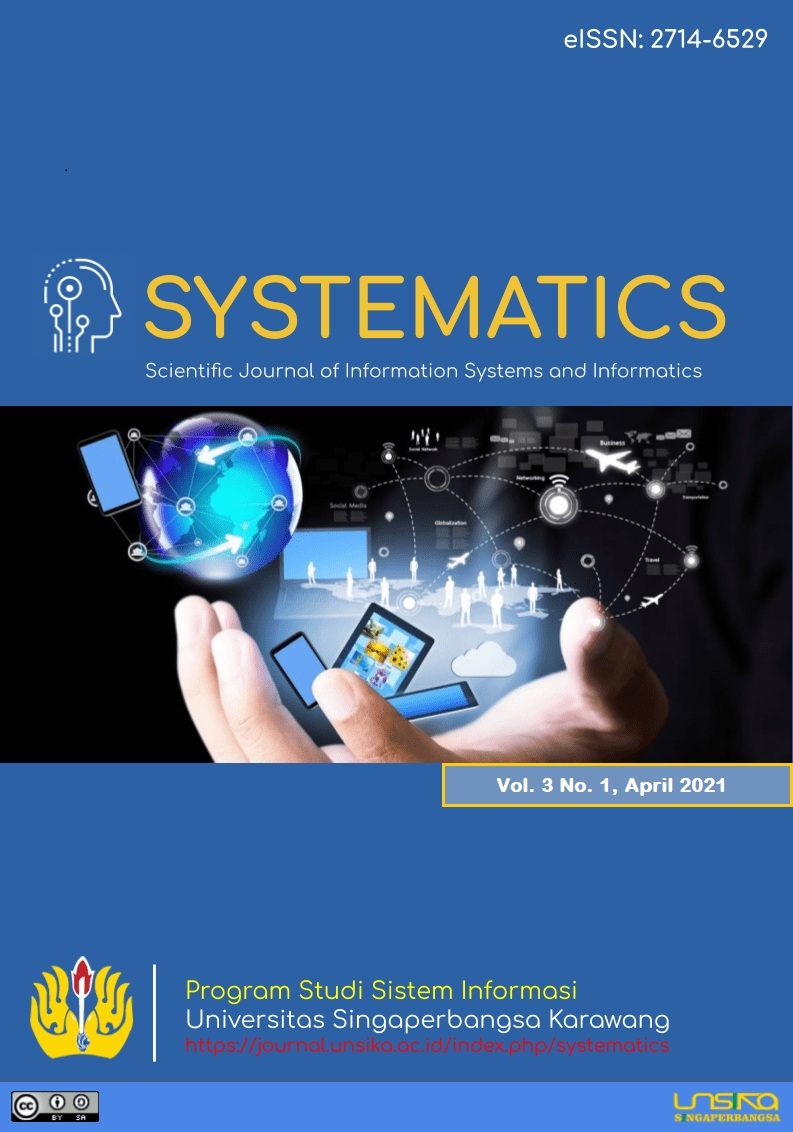Decision Support System for Feasibility of Marketing Chicken Using Weighted Product Method
Sistem Pendukung Keputusan Kelayakan Pemasaran Ayam Menggunakan Metode Weighted Product
DOI:
https://doi.org/10.35706/sys.v3i1.5521Abstract
Chicken is a farm animal that is loved by many people, where chicken contains many things that are needed by the body. To get the best chicken, the company needs to conduct a selection in determining the best chicken to be marketed to consumers. Selection Determining the best chicken to be marketed is part of the selection process. In the process of determining the best chicken PT. Japfa com feed Indonesia Tbk is carried out with a series of tests in the form of chicken size, feather color, weight, and body temperature. Therefore we need a decision support system with the weighted product (WP) method as an alternative solution of choice so that it runs effectively and reduces subjective assessments. From the test data, it can be concluded that the system is able to provide alternative choices effectively and reduce the element of subjectivity with a margin of error of 90% when compared to the same selection system.
Downloads
References
Wendra, Fadhli, and dkk "Sistem Pendukung Keputusan Seleksi Penerima Besiswa Pada SMKN 8 Padang Dengan Menggunakan Metode Weighted Product," Jurnal Ilmiah METADATA, Volume 2 Nomor 3 September 2020.
Wahid, Jamil and dkk " Sistem Pendukung Keputusan Kelayakan Penerimaan Bantuan Beras Sejahtera (Rastra) Dengan Menggunakan Metode Weighted Product," Jurnal PROtek Volume 06. No 2, September 2019.
Oktavia,”Sistem Pendukung Keputusan Seleksi Penerima Beasiswa Dengan Metode Weighted Product Pada SMP Negeri 1 Parung berbasis Web,” Jurnal Informatika Universitas Pamulang Vol 3, No.2, Juni 2018.
W.Nugroho and Y.Brianorman, "Decision Support System For Purchase Of Using The Weighted Product Method," Jurnal Digital Teknologi Informasi Volume 3 Nomor 2 2020.
D.Zidifaldi and Y.Brianorman, “Decision Support System in Choosing a Gaming Laptop and Content Creator as Needed Using The Weighted Product Method,” Jurnal Digital Teknologi Informasi Volume 3 Nomor 2 2020
E.W.Puspitarini, “Sistem Pendukung Keputusan dalam Menentukan Penerima BLT dengan Metode Weighted Product Model,” MATIKA Jurnal Volume 07 Nomor 02, Oktober Tahun 2017.
I.Y.Ruhiawati and M.Y.Romdoni, “Sistem Pendukung Keputusan Pemilihan Bahan Baku Produksi Dengan Metode Weighted Product Pada PT. Luhai Industri,” Jurnal SIMIKA Vol. 3 No.1 Tahun 2020.
A.Jalil, I.P.Ningrum and dkk, “Spk Pemberian Kredit Menggunakan Metode Wp (Weighted Product) Pada Bmt Mu’amalah Sejahtera Kendari,” semanTIK, Vol.3, No.1, Jan-Jun 2017, pp. 173-180.
H.Supriyono, C.P.Sari, “Developing Decision Support Systems Using the Weighted Product Method for House Selection,” Cite as AIP Conference Proceedings 1977, 020049 (2018).
M.Muslihudin, dkk, “Application of Weighted Product Method for Determining Home Renovation Assistance in Pringsewu District,” International Journal of Recent Technology and Engineering (IJRTE) ISSN: 2277-3878, Volume-8, Issue-2S2, July 2019.
M.Aminudin, dkk, “Weighted Product and Its Application to Measure Employee Performance,” International Journal of Engineering & Technology, 7 (2.26) (2018) 102-108.
Oktafianto, dkk, “Determining housing location using the weighted product,” International Journal of Engineering & Technology, 7 (4) (2018) 3563-3568.
G.Sisodia, dkk, “Intuitionistic Fuzzy Weighted Sum and Product Method for Electronic Service Quality Selection Problem,” I.J. Modern Education and Computer Science, 2018, 9, 33-43.
A.Setyawan, dkk, “Comparative Analysis of Simple Additive Weighting Method and Weighted Product Method to New Employee Recruitment Decision Support System (DSS) at PT. Warta Media Nusantara,” Scientific Journal of Informatics Vol. 4, No. 1, May 2017.
Downloads
Published
How to Cite
Issue
Section
License
Copyright (c) 2021 SYSTEMATICS

This work is licensed under a Creative Commons Attribution-ShareAlike 4.0 International License.
Authors who publish with this journal agree to the following terms:
- Authors retain copyright and grant the journal right of first publication with the work simultaneously licensed under a Creative Commons Attribution-ShareAlike 4.0 International License. that allows others to share the work with an acknowledgement of the work's authorship and initial publication in this journal.
- Authors are able to enter into separate, additional contractual arrangements for the non-exclusive distribution of the journal's published version of the work (e.g., post it to an institutional repository or publish it in a book), with an acknowledgement of its initial publication in this journal.
- Authors are permitted and encouraged to post their work online (e.g., in institutional repositories or on their website) prior to and during the submission process, as it can lead to productive exchanges, as well as earlier and greater citation of published work (See The Effect of Open Access).







